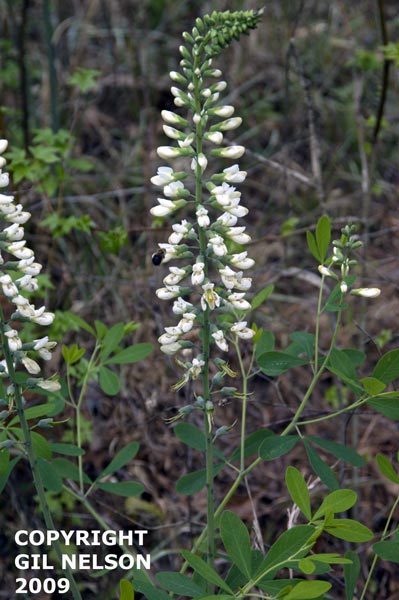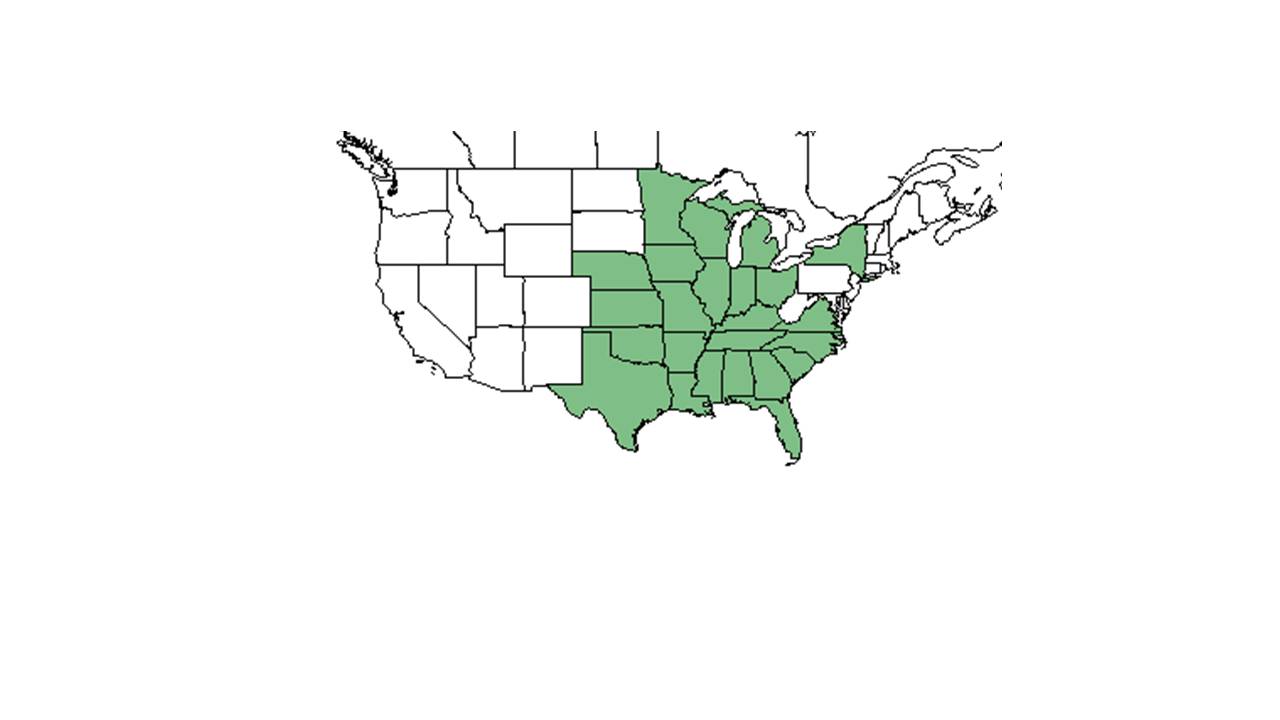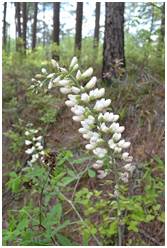Difference between revisions of "Baptisia alba"
Krobertson (talk | contribs) (→Description) |
Krobertson (talk | contribs) (→Distribution) |
||
| Line 30: | Line 30: | ||
==Distribution== | ==Distribution== | ||
| − | Native to the southeastern United States from Virginia to central Florida<ref name="floridata">[[http://floridata.com/Plants/Fabaceae/Baptisia%20alba/681]]Floridata. Accessed: April 4, 2016</ref> | + | Native to the southeastern United States from Virginia to central Florida.<ref name="floridata">[[http://floridata.com/Plants/Fabaceae/Baptisia%20alba/681]]Floridata. Accessed: April 4, 2016</ref> |
==Ecology== | ==Ecology== | ||
Revision as of 19:24, 10 August 2016
| Baptisia alba | |
|---|---|

| |
| photo by Gil Nelson | |
| Scientific classification | |
| Kingdom: | Plantae |
| Division: | Magnoliophyta - Flowering plants |
| Class: | Magnoliopsida - Dicotyledons |
| Order: | Fabales |
| Family: | Fabaceae ⁄ Leguminosae |
| Genus: | Baptisia |
| Species: | B. alba |
| Binomial name | |
| Baptisia alba (L.) Farw. | |

| |
| Natural range of Baptisia alba from USDA NRCS Plants Database. | |
Common name: white wild indigo
Contents
Taxonomic notes
Synonyms: Baptisia alba var. alba; B. lactea (Rafinesque) Thieret var. obovata (Larisey) Isely; B. lactea var. pendula (Larisey) B.L. Turner; B. pendula Larisey; B. pendula var. pendula; B. pendula var. obovata Larisey
The genus name comes from the Greek word "bapto" meaning to dye, the specific epithet means white.[1]
Description
For the Baptisia genus, the group are rhizomatous perennial herbs which blackening when dried. The leaves are 3-foliolate or rarely simple. The flowers are papilionaceous, either solitary or in axillary or in terminal racemes. The calyx is persistent, is 4-5 toothed (or lobed), is campanulate, the upper lip is entire, the is notched or 2-lobed. The petals can be white, cream, yellow or blue in color. The petals are orbicular to reniform and usually reflexed and are shorter than the wing and keel petals. There are 10 stamens, the filaments are distinct, ovary stipitate in shape. The legume has a papery to almost woody feel in texture, is inflated, stalked, globose to cylindric in shape, and contains many small seeds.[2]
Specifically, for Baptisia alba, the plants are glaucous, glabrous or close to it. The plants grow up to 0.5-1.2 m tall. The leaves contains the 3-foliolate, the leaflets are elliptic, oblanceolate to obovate in shape, and growing up to 2-4 (6) cm long, and 0.8- 1.5 cm wide. The stipules become deciduous, deltoid to lanceolate, and grow up to 5 mm long. The racemes are long, slender, and terminal, and growing up to 1.5-5 dm long. The (2) pedicels grow up to 4-12 mm long subtended by caducous bracts that grow up to 5-7 mm long. The calyx is glabrous except for the short-ciliate margin. When dried, changes to a greenish yellow to straw color. Of the calyx, the upper lip is entire or slightly emarginated, the corolla is white in color, and the keel and wing petals grow up to 1.2-1.8 cm long. The legume is usually erect, is light brown in color, is cylindric in shape, and grows up to 2-3.5 cm long and up to 5-10 mm in diameter.[2]
Distribution
Native to the southeastern United States from Virginia to central Florida.[3]
Ecology
Habitat
Baptisia alba is found dry habitats such as in pine flatwoods, along the edges of mesic thickets and bottomland woodlands, in open upland pine-hardwood sand ridges, well-drained hardwood hammocks, and open upland woods. It can also be found in some disturbed habitats, namely on moist roadsides and along hiking trails and railways. This species appears in a range of light levels, from shady to sunny, and in mostly sandy soil types such as loamy sand and drying sandy loam[4].
Phenology
B. alba grows from a rhizomatous root sytem with a taproot sending up one to several stems[5]. It exhibits asynchronous flowering[6]. Blooms April through July[3]. The fruit is a membranous to ligneous legume[7].
Seed dispersal
The legume pod dehisces vertically releasing seeds[7].
Fire ecology
It inhabits annually burned pinelands, which implies fire tolerance[4]. A deep taproot allows for resprouting after fires[3]. There is a greater reproductive productivity in burned areas[6].
Pollination
Bombus species are the major pollinators[6].
Use by animals
Toxic to cows[8].
Conservation and management
Cultivation and restoration
This species takes several years to establish, however, once established it is extremely long lived[3].
Photo Gallery
Baptisia alba at Pebble Hill Plantation[9]
References and notes
- ↑ [[1]] Missouri Botanical Gardens. Accessed: April 4, 2016
- ↑ 2.0 2.1 .Radford, Albert E., Harry E. Ahles, and C. Ritchie Bell. Manual of the Vascular Flora of the Carolinas. 1964, 1968. The University of North Carolina Press. 580-2. Print.
- ↑ 3.0 3.1 3.2 3.3 [[2]]Floridata. Accessed: April 4, 2016
- ↑ 4.0 4.1 Florida State University Robert K. Godfrey Herbarium database. URL: http://herbarium.bio.fsu.edu. Last accessed: June 2014. Collectors: H. E. Ahles, L. C. Anderson, R. Athey, K. E. Blum, M. B. Brooks, J. R. Burkhalter, A. F. Clewell, D.S. Correll, R. F. Doren, W. H. Duncan, L. R. Fox, J. P. Gillespie, R. K. Godfrey, N. C. Henderson, R. H. Houk, G. R. Knight, R. Komarek, R. Kral, R. L. Lazor, R.S. Leisner, K. MacClendon, A. W. Macias, S. McDaniel, R. Mitchell, G. W. Ramsey, J. D. Ray Jr., L. M. Umbach, and R. L. Wilbur. States and Counties: Florida: Calhoun, Dixie, Escambia, Gadsden, Jackson, Jefferson, Lafayette, Leon, Madison, Suwannee, Taylor, Wakulla, and Washington. Georgia: Grady, Fannin, Lowndes, Taliaferro, Thomas, and White. Kansas: Franklin. Mississippi: Hancock and Panola. Missouri: Vernon. North Carolina: Stanly. South Carolina: Lancaster, Richland, and Sumter. Texas: Red River.
- ↑ [[3]]Accessed: April 4, 2016
- ↑ 6.0 6.1 6.2 Petersen, C. E., J. B. Ciesielski, et al. (2009). "A two-year study of the reproductive phenology of Baptisia alba (Fabaceae)." Transactions of the Illinois State Academy of Science 103.
- ↑ 7.0 7.1 Mehlman, D. W. (1993). "Tumbleweed Dispersal in Florida Sandhill Baptisia (Fabaceae)." Bulletin of the Torrey Botanical Club 120(1): 60-63.
- ↑ [[http://www.wildflower.org/plants/result.php?id_plant=BAAL Lady Bird Johnson Wildflower Center. Accessed: April 4, 2016
- ↑ Photographed and identified by Kevin Robertson at Pebble Hill
